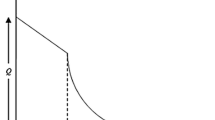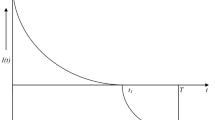Abstract
Most researchers established their inventory lot-size models under trade credit financing by assuming that the supplier offers the retailer fully permissible delay in payments and the products received are all non-defective. However, in the real business environment, it often can be observed that the supplier offers the retailer a fully permissible delay in payments only when the order quantity is greater than or equal to the predetermined quantity Q d . In addition, an arriving order lot usually contains some defective items due to imperfect production processes or other factors. To capture this reality, the paper extends Huang (2007) economic order quantity (EOQ) model with partially permissible delay in payments to consider defective items. We formulate the proposed problem as a profit maximization EOQ model in which the replenishment cycle time is the decision variable. Then we use the arithmetic-geometric mean inequality approach to determine the optimal solution under various situations. An algorithm to obtain the optimal solution is also provided. Finally, the numerical examples and sensitivity analysis are given to illustrate the results.
Similar content being viewed by others
References
Aggarwal SP, Jaggi CK (1995) Ordering policies of deteriorating items under permissible delay in payments. J Oper Res Soc 46: 658–662
Balkhi ZT (2004) An optimal solution of a general lot size inventory model with deteriorated and imperfect products, taking into account inflation and time value of money. Int J Syst Sci 35: 87–96
Chang CT (2004) An EOQ model with deteriorating items under inflation when supplier credits linked to order quantity. Int J Prod Econ 88: 307–316
Chang CT, Ouyang LY, Teng JT (2003) An EOQ model for deteriorating items under supplier credits linked to ordering quantity. Appl Math Model 27: 983–996
Emery GW (1987) An optimal financial response to variable demand. J Financ Quant Anal 22: 209–225
Goyal SK (1985) Economic order quantity under conditions of permissible delay in payments. J Oper Res Soc 36: 335–339
Hou KL, Lin LC (2004) Optimal production run length and capital investment in quality improvement with an imperfect production process. Int J Syst Sci 35: 133–137
Huang YF (2007) Economic order quantity under conditionally permissible delay in payments. Eur J Oper Res 176: 911–924
Mondal B, Bhunia AK, Maiti M (2009) Inventory models for defective items incorporating marketing decisions with variable production cost. Appl Math Model 33: 2845–2852
Ouyang LY, Chuang BR, Wu KS (1999) Optimal inventory policies involving variable lead time with defective items. Opserach 36: 374–389
Paknejad MJ, Nasri F, Affisco JF (1995) Defective units in a continuous review (s,Q) system. Int J Prod Res 33: 2767–2777
Papachristos S, Konstantaras I (2006) Economic ordering quantity models for items with imperfect quality. Int J Prod Econ 100: 148–154
Petersen MA, Rajan RG (1997) Trade credit: theories and evidence. Rev Financ Stud 10: 661–691
Porteus EL (1986) Optimal lot sizing, process quality improvement and setup cost reduction. Oper Res 34: 137–144
Rosenblatt MJ, Lee HL (1986) Economic production cycles with imperfect production processes. IIE Trans 18: 48–55
Salameh MK, Jaber MY (2000) Economic production quantity model for items with imperfect quality. Int J Prod Econ 64: 59–64
Teng JT (2002) On the economic order quantity under conditions of permissible delay in payments. J Oper Res Soc 53: 915–918
Teng JT (2009) Optimal ordering policies for a retailer who offers distinct trade credits to its good and bad credit customers. Int J Prod Econ 119: 415–423
Wu KS, Ouyang LY (2000) Defective units in (Q, r, L) inventory model with sublot sampling inspection. Prod Plan Control 11: 179–186
Wu KS, Ouyang LY (2001) (Q, r, L) inventory model with defective items. Comput Ind Eng 39: 173–185
Author information
Authors and Affiliations
Corresponding author
Rights and permissions
About this article
Cite this article
Ouyang, LY., Chang, CT. & Shum, P. The EOQ with defective items and partially permissible delay in payments linked to order quantity derived algebraically. Cent Eur J Oper Res 20, 141–160 (2012). https://doi.org/10.1007/s10100-010-0160-9
Published:
Issue Date:
DOI: https://doi.org/10.1007/s10100-010-0160-9




